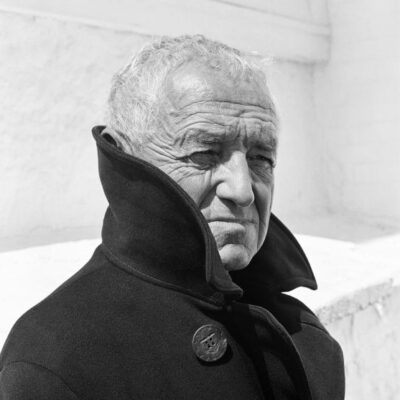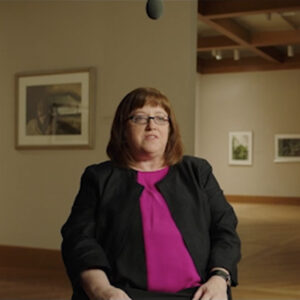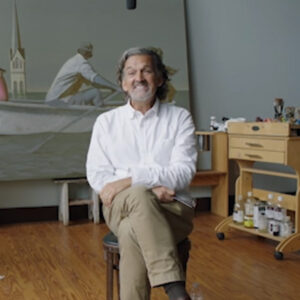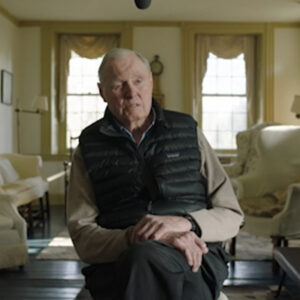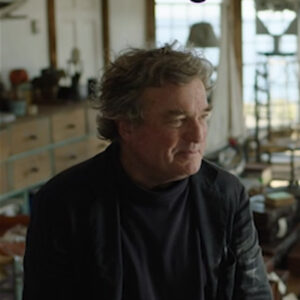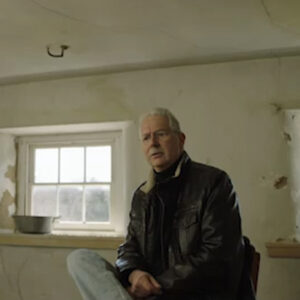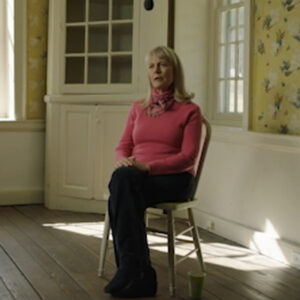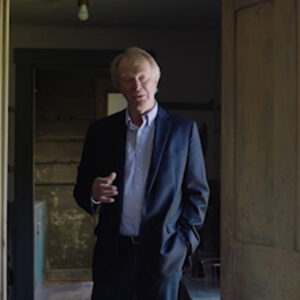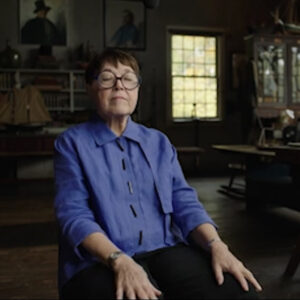Speaker I’m Christine Padman Netsky, curator of an CYF collections at the Brandywine River Museum, and this is the NCIS studio.
Speaker Talk to me about this space. What does it feel like? What’s in here? How did he use this space?
Speaker This was the space where he basically created the characters and the settings for those characters, for all of his illustrations. This was where he put the the paint on the canvas right here.
Speaker Can you talk to me about NCES career? We’ll talk about his relationship with Amy Schumer to talk more about his career as an illustrator and sort of like the.
Speaker The achievement that he made in that in that arena, he made it very quickly, actually, he was a student of Howard Pyle, another very famous illustrator for just a couple of years. And then he began to work in primarily Western illustration because Howard pilots suggested that each of his students have a specialty. And NCIS, as a young man, decided the West would be his specialty. So he painted Western subjects. He visited the West several times and very quickly, within probably six years or so, became very famous as a Western artist, really rivaling Remington and Charles Russell in in fame. But he decided the more he spent time in child Ford in the countryside here, that this was was better suited to his character, that he wasn’t really a Western man. So he moved here and built the studio and then began to work for for Scribner’s. Scribner’s was one of his major clients. And fortunately for him and Scribner’s in 1911, they offered him a commission to do Treasure Island to illustrate Treasure Island was not the first time Scribner’s had published Treasure Island, but this was to be the first time there were big, bold illustrations for it.
Speaker And why did that?
Speaker They were an absolute sensation. And for the next decade, I would say he churned out these Scribner’s books every year, every other year, all the classics Robinson Crusoe Boys, King Arthur, all the classics. And he became known as a classic illustrator for these very classic stories that are fantastic in which they are.
Speaker Can you talk about those of you just a little bit and say, oh, westerner’s I’m not sure a Western artist mean when you say you work with some of the images that we do?
Speaker Well, at that time, at the beginning of the 20th century, the West was a very popular popular concept, especially for the Eastern magazines, that sort of thing.
Speaker And a lot of artists went west to soak it up, soak up the spirit. The West was, of course, very rapidly modernizing. It was no longer the old West. And I think that was part of NCIS problem, too, is when he got there, he realized that the old West was was no longer there, but it was the route up. Shoot him up the the the the Cowboys with the Pistols and the Native Americans hunting and that sort of thing perfectly.
Speaker He didn’t. Could you talk to me about this studio and its proximity to the house and talking about the life of an everyday people in Australia, but there’s also a father and how what is it kind of every day was like.
Speaker Sure. And CYF was.
Speaker It was very deliberate, I I’m positive, in the way he set up his life, he knew that he wanted to be very involved in the upbringing of his children. And so he built this studio, which is literally 25 steps and a short walk away from the house. And so he would in the morning get the kids breakfast and then trudge up the stairs to the studio. His wife would call him down for a noontime meal, and he would often, as the children got older, I’m sure, have them around or at least enjoy their running through the woods or that sort of thing.
Speaker Can you tell me how we know about Andrew and see what it’s like life, I mean, and wife was a fabulous correspondent.
Speaker And one of the ways that we know so much about, not only his life is an illustrator, but also the family life here on what was called Rocky Hill was the fact that he had a very lively correspondence with his family in Needham, Massachusetts. He wrote, I’m not going to say he did not write his mother every day, but perhaps in the beginning, maybe two or three times a week, he would write his his mother or his brothers as they grew older. Occasionally, his father and but his mother was his principal corresponded and described not only, as I said, the work he was doing here in the studio, but also how he was addressing the needs of the children, the various sort of whether they were having here on the hill, the crops he was growing, that sort of thing. So it’s very, very detailed and intimate picture of family life in southeastern Pennsylvania in the early part of the 20th century.
Speaker I think it is a good word this. I’m struck by his self-doubt and questioning. But also it’s like I feel that sometimes when he’s writing the letters from Transparency’s encouraging himself, because there’s a lot of sort of motivation that talk in the letters that there is motivational talk in the letters.
Speaker He very much wanted to be a painter, not an illustrator. And in the first half of the 20th century, that was a distinction that almost everyone in the art business, shall we say, made.
Speaker You were a painter or you were an illustrator and and CYF. It was important for him to have a family. He kept having children and he needed to support that family and he could do that very well with illustration. Being a pure painter was a little bit more of a risk. And at that particular time, when the children were small, he although he did do landscapes and portraits in his spare time, he certainly wasn’t ready to throw it over and become a starving artist in a garret.
Speaker Can you tell me about the size of his family and also in the same sort of discussion, talk about the income that he was allowed to generate with this kind of work? Not necessarily dollars, but he was successful. What was able to handle all the money coming in?
Speaker Right. Let me just give a thought here as far as the income coming in.
Speaker He and his wife ended up having a family of five children. There were three girls and two boys and they did not and see why I supported them very well. But they did not by any means live a life of luxury. It was they were very frugal. I have the she was a very good homemaker.
Speaker They grew a lot of the vegetables. She canned a lot of the foods that they used in the wintertime. I’m sure she sewed a lot of their clothes. So it was not it was not a well-to-do life, but it was certainly ency. Wife and his wife were very convinced that it was a wholesome, hardy life.
Speaker And they they were, in many respects, very pleased with it. While the countryside was being populated by various members of the Dupont family and large, large estates. He was more or less pleased with with what he had carved out here for himself.
Speaker Could you tell me what we know about her name?
Speaker Her name? His wife was the former Carolyn Backus of Wilmington, Delaware. She came from a family of 12 children.
Speaker So it was kind of a rightist family for her. And she was either the first or the second eldest. She came from her mother in particular, was very well read. And in fact, it was her mother who introduced NCIS to the work of Henry David Thoreau, which would be very important to NCIS almost as soon as she picked up the first book. So Carolyn was very much a homemaker.
Speaker I think she enjoyed her role in this in this whole production. And while she was not artistic at all, she realized, I think, that she was an NC wife would write this, that she was really the anchor that kept them together.
Speaker Can you talk about this location and what we know about why he decided to stay here versus going back to Massachusetts?
Speaker After studies NC Wyeth was struck by this area. He felt that it reminded him a little bit of New England. He realized that it was a pretty good area for in which to be an illustrator.
Speaker There was a lot of there were a lot of publishing houses in Philadelphia. Curtis, for example, of Saturday Evening Post was there.
Speaker This village was although small, it was not isolated. He could take the train to New York and be back in a day. So his his whole he was a country boy. He was not a city boy. And in fact, the wives decided in 1921 that they would leave Chadds Ford and move back to Massachusetts, where he was originally from. But when they got there and spent two years there, they realized that the Needham area had become too citified for them. And fortunately for all of us, they had only rented this property. They didn’t sell it. So they were able to move back here. And then he knew then in the depths of his heart that this is where his his place was.
Speaker It’s true. I love reading in the letters that we walk to Wilmington today. All right. So talk to me about his priorities as a painter, but also as a father. What did he want to give his children?
Speaker And see why I thought that creative adults retained the spirit of childhood. So it was very important for him to make that that childhood for each of his children so incredibly valuable through memory that they would take that on into their their adult lives, their adult creative lives.
Speaker Let me just take that last sentence again, because I like it so much, he thought that basically.
Speaker Having a to take it and see why I thought that a creative childhood would take you all the way through your adult life, especially if, as he hoped, his children would be very creative adults.
Speaker So what are some of the things that he did to create a creative and special childhood?
Speaker It’s amazing what he did as a father for his children, first of all.
Speaker There was NCUA of himself, and I think they must have realized, right, right, as soon as they were able to. What an incredible imagination NC Wyeth had. I mean, here were here. Here he was in the studio creating these characters, creating these scenes, the settings. And then and then he was taking that creativity and using it in different ways.
Speaker For example, a number of the children, three of them, I think all had birthdays in October, around the same time in CYF did. So they would have a general birthday party and they would always have a party here in the studio. It was a family party, but they would bring in because it was October, they would bring in sheaves of of corn and pumpkins and they’d set them up on that model, stand in the back there and light jack lanterns in the middle of it and just have a very creative time of it. And then you have the Christmases that he created for his children. Were they they remembered these Christmases all their lives. He would dress as Santa Claus.
Speaker He had a number of of very woolly coats that he had gotten. A couple of them had gotten out. So it wasn’t the traditional Saint Nick that we know. And he had rather, I understand, rather grotesque mask. But he dressed up and and he actually would on Christmas morning, scaled the roof of the house, take his sleigh bells, ring them up and down the chimney and tromp around on the roof. Meanwhile, the children are all snug in their beds, trembling with that sort of excitement and fear, that mix of excitement and fear that Santa Claus was coming. Saint Nick was coming.
Speaker So he would do that and then he would also talk about Andrew. Andrew did a lot of Robin Hood acting that a lot of plays and costumes, those are made available to children.
Speaker Exactly. There were a lot of costumes made available. And whether those were the costumes that NCIS kept here in the studio or whether those were costumes that Carolyn made for the children, I’m not really sure. But the the children were costumed in whatever they wanted. As you say, Robin Hood, King Arthur running through the woods.
Speaker We have in the prop room here a broad axe. And it is a homemade broadnax, but it even has a little bit of blood on the on the blade. And I’m sure that that was a prop for the children quiver as the arrows bow and arrows for Robin Hood, everything was was made for them. Everything that could stimulate their imagination sounds fantastic.
Speaker Yes. Let’s talk about this space. And it’s a young Andrew White in it. I mean, what would Andrew I have experienced here as a boy? I was, I guess, before I know him so and I’m teaching him as an artist.
Speaker I’m not either OK, and I yeah, I’m not sure what exact date it was that I was as a teenager.
Speaker So let’s talk about the process and he needed to execute his work, the fact that those were around and we can get started to dip into the war memory. OK.
Speaker The studio was full of props that NCIS needed as an illustrator. And I think that some of the things well, I can listen. There are swords. There are guns here.
Speaker There was there were certainly costumes, although a lot of those haven’t haven’t survived. Are things like saddle’s. There were snowshoes. There’s a there’s a wooden horse form for the saddles to go on.
Speaker Just anything that NC Wyeth could use to set up a model or something.
Speaker He would he would set up a model. And it wasn’t that he couldn’t he couldn’t paint a model. He couldn’t paint a model without sitting someone on a on a horse form. It was it was he was looking for the the the muscles that the the model would use while sitting on a form that looked like a horse, that sort of thing. The same way with the guns, for example, that are here in the studio, you use certain muscles. There was a certain stance to hold a rifle, to fire a rifle. And this is what NCIS was interested in. And this is why he kept the props. So these were all available to the children. And one of the things that most fascinated Andrew with as a boy of, say, eight, nine or ten, what were the amount of World War One objects that were here in the studio? And CYF did not go abroad during World War One, but he was absolutely critically aware that the by not going abroad, he was putting himself at a disadvantage. He was not experiencing the war as many artists did. Right. In Europe. So he spent a lot of time saving rotogravure sections from New York Times, from The New York Times, from the Philadelphia Inquirer. He saved a lot of photographs that he would find in other magazines. He collected helmets, guns, anything. I know for a fact that one of his Howard Pyle school buddies sent him a German rifle, that that artist who had gone abroad had liberated from a bunker from a trench in Germany. So there were there was all this material in the studio for and for a boy of Andrew Ice Age who was interested in the war. It was it was just it was all right here. There were over 250 pages of rotogravure sections from The New York Times, which we know from Andrew Wyeth’s writings later on that he would sit in the studio here and page through them looking at the the war imagery.
Speaker Let’s talk about the war imagery. Can you also help me with that? I’m sure everyone will know that it is so. OK, tell me what they are. They were like pictorial displays, pictures. Right. So if you could explain that a little bit. And then we did film some of the stuff that go into detail about what some of the images that I think.
Speaker Because is still early on in the reproduction of imagery, rotogravure were a particular type of it was it was a way to reproduce a photograph, but it had to be done a special press. And so these were done in special sections. They were not done well. There was little text below them, but they were not done in columns, the way a newspaper, the way the rest of the newspaper was. So and and in fact, I think some of these rotogravure say actually had to be touched up because, again, they were not they just didn’t have the technology to reproduce photographs. They also didn’t have the technology to take the pictures the way we do today as well. So but you would have these sections that would come with The Sun newspaper. They were three or four or five pages full size. And they would it would be an odd mix, actually, of war imagery in the front and society photographs in the back.
Speaker But during the war years, especially a fairly fairly graphic images of of of the war goings on in Europe and some of the other things made available to enter at that time were the.
Speaker The three day things, one of that’s about.
Speaker And CYF also had in the studio a lot of they were let’s start again with if I can’t remember the name of the word. And CYF also had in the studio the it was called The World’s War through the Stereoscope. It was published in 1923. They were boxes of stereo cards to images the same image, but not quite because they were taken by by a dual camera on little cards, maybe, let’s say eight inches by two inches. You would put these in a handheld machine. Machine is the wrong word because it wasn’t a machine. It was merely a a lens and then a a a piece of wood that would slide back and forth that you would adjust to your own eyesight. And as you adjusted this, you would bring the card in.
Speaker The two images on the card would come into focus, but it would come into 3D focus. So we’d have this amazing 3D image in front of you of the battlefields in France, the trenches of villages that had been totally bombed. These images were very, very detailed. They were very crisp. You could see everything in them. And when I say everything, I mean there were bodies, of course, human bodies. There were horse carcasses. There was, of course, all sorts of mangled machinery. Really, the horror of the war is absolutely displayed in these images. And as I might have said, there were 300 of these cards in this set where you could see the war in 3D. And really you could only you could only see that otherwise at the newsreels, there was no other way you could get a 3D image of what was going on in Europe.
Speaker So to have that any moment in time with front of this, to sit with and spend time with, to visualize the images just to and and to to look to study, for example, the ground, what was in the ground there, and some of those pictures to study how the perspective worked in some of those pictures.
Speaker And I don’t mean to imply that the young Andrew Wyeth was actually studying them, per say, but he was internalizing this imagery and it would come out later in his artwork.
Speaker That’s great. I love that I early three things, I’ve had a lot of new information for people. Can you talk to me about the book that we filmed yesterday with all those other illustrations and who made them wax here and what you think Andrew might have gleaned from that book?
Speaker Another important source for Andrew Isolator work was a book here in the studio that.
Speaker We’ll start again, yeah, that’s exactly right.
Speaker Andrew, I found in the studio another war book that would be very important to him as a source for his visual memories. This was a book of the watercolors of Claggett Wilson. Chiger Wilson was an American artist who enlisted in the First World War and went to Europe, fought in France. He was not an official World War One artist, but he did go over and experience the horrors of war, which caused him to work some of that out in watercolor. They’re absolutely amazing watercolors, somewhat primitive, but very visceral and very, very free with watercolors. Andrew Wyeth, we know, discovered this book in his father’s studio. It’s it’s a large folio size. And when you open the front cover, the first thing you see is to Andy from Papà in the handwriting of the young Andrew Wyeth.
Speaker And I’m sure it was one of those incidences where and Andrew said to his father, Pop, may I have it and see? So I said, Sure. And so, Andrew, to make sure that his father remembered that inscribed it as quickly as he could.
Speaker But these images, I think, gave Andrew Wyeth, who was at the same time doing his own watercolors of World War One scenes, they gave him they they showed him how powerful watercolor could be and how expressive watercolor could be.
Speaker It gave him it gave Andy a freedom to to just work watercolor in any way he wanted to. And again, this is a child, but he’s internalizing all of this and and the watercolor, especially what he learns, I think, from from doing these World War One drawings of his own soldiers in watercolor and from looking at Claggett Wilson’s drawings in watercolor, is that by the time he gets to be a young man and he’s really working in watercolor in Maine, he he he knows the medium and he knows he knows what it can do and he knows not to be afraid of it. He’s willing to just spew it here, there and everywhere. And when you look at the freedom of those early Nain watercolors, you see that he is he had internalized all this, I think, as a child from working in watercolor with his World War One drawings. And it wasn’t.
Speaker It’s beautifully stated, I think it’s another fun thing to think about, it’s like the other the warm memories I read in your chapter, like when he comes over the hill, meets Culcairn, and all of a sudden he finds that Coughenour was a of one. Soldier, that stuff triggered it. Can you talk about, like, what was gathered here and his in his memory and then how it sort of was working, worked out through the rest of his life with the Kurds and.
Speaker So not only did Andrew Wyeth establish this, but I like to call this war in memory of the images and his toy soldiers and his costumes.
Speaker Did he establish all of that here? He had the good fortune to one day scurry down the lane and over a hill and run into a new neighbor. Who was Carl Karsner? The Kerner’s had moved to child support in 1923. They rented a dairy farm nearby, and Carl Karsner happened to be a World War One and World War II, where one soldier and I have to go back and do that again because Carl didn’t move here in 1923 because he came to the United States in 1923. They moved here to Charles Ford in 1926. So where should I forget sort?
Speaker I said you use this term war memory that you’ve written about. So if you could. Begin with that thought.
Speaker All right, so so Andrew Wyeth, we don’t want to start with.
Speaker So excuse me.
Speaker Andrew Wyeth is a child, then spent a lot of time looking at these rotogravure, at the stereo cards, at the objects that his father had collected from various former soldiers, he had known helmets, coat, gray coats, that sort of thing.
Speaker So he had pretty much established his own war memory.
Speaker And then in 1926, he scurries down the lane over a hill and he meets a new neighbor in child sport, Carl Karsner. Carl had moved just moved to town with his family. They were renting a dairy farm. Carl was a former machine gunner in the German army.
Speaker And all of a sudden it was as if Andrew Wyeth, one of his toy soldiers, had come to life because there was Carl Karsner with his helmet and his medals and his coat and his scars and his battle stories willing in his broken English to speak to Andrew Wyeth. So there was another layer there of of World War One memory going in to Andrew Wyeth. He became he developed a relationship with Carl Kirner as a boy and then later went back as a mature artist to paint Carl until Carl died. And in fact, even after Carl died, he painted Calcagno.
Speaker I mean, not that kind of, but that we didn’t talk about the twins, so it’d be great. I’m glad you brought us back up at that time. And you are doing beautifully.
Speaker Did you just Christine? I the very first thing you said, um, you said you worked at the Brown University.
Speaker So can you say, OK, our camera went up and up and up, it was like a scene from a movie, but it is kept coming, right?
Speaker Another way that Andrew Wyeth played World War One, if you will, was with toy soldiers and miniature miniature soldiers, these were imported into the United States from Germany at the beginning of the 1920s. They were available in department stores and CYF and his wife would go into Philadelphia to Wanamaker’s and for a gift giving occasion like Christmas or birthday, they would buy Andrew. While some of these toy soldiers, they were about four inches high. They were made of a combination of glue and sawdust on a wire armature by companies Blastland and Lyonel in Germany. They were very, very accurate in their depiction of soldiers, both American soldiers and German soldiers.
Speaker So you would have you would have everything from the medics to the machine gunners. You would have the dogs, you would have the tents. And indeed and always seems to have had all of that, an incredible collection of these of these miniature soldiers. He he played with them. They have been for years. For decades. They’ve sat on shelves and been more or less preserved. But in the beginning, Andrew Wyeth actually played with them as a child. I remember his son Nicky told me at one point that his father had told him that Andrew would actually go outside and dig trenches and put these soldiers in the trenches and then blow them up and then presumably rush out with this watercolors and paint the chaos that ensued. In any case, these were the soldiers that Andy Wood would use and he kept with them actually for the rest of his life as an adult, he would add to this collection. And I think that one of the reasons just having these soldiers around was a way that Andrew Wyeth could, by looking at them, remind himself of some of the excitement and exhilaration that he experienced as a child when he played with these. And again, it was a way to to work into these emotions.
Speaker Did Andrew start studying and seeing this face? Yes, so can you talk to me about that, about that Andrew and he tutored?
Speaker Gosh, I wish I knew the date, but I do not know the date of when he was so young. OK, it’s fun.
Speaker So as a as a teenager, as a young teenager, Andrew Wyeth was after several after he’d accomplished several remarkable ink drawings of medieval soldiers, his father realized that he was ready to enter the studio as a as a student. So he. Shoulder, it is his pencils and his brushes and came in while his father had a very strict curriculum, if you will, laid out, and Andrew didn’t really start painting here in the studio for quite a while. His father had him begin with very intensive study of geometric geometric shaped objects and drawing perspective, drawing light and shadow and that sort of thing. And it was only after Andrew mastered all of that and and the plaster cast here in the studio, he was allowed to draw from what? And then and then still lifes. Was he able to actually get to oil painting? And so a lot of people don’t realize that the Andrew Wyeth did do a number of oil paintings here in the studio under his father’s under his father’s guidance.
Speaker What was I think we talked about this before and please forgive me, but what was his father’s lessons about learning all that? What was his major lesson that he wanted to give in to the perspectives and all that kind of pencil drawing?
Speaker I think the major thing that I was trying to teach, Andrew, was to observe closely and CYF. Knew that he had a very imaginative boy, that was the next step, but I think that ANCYL felt that unless you observed closely, you couldn’t lay your imagination on until you had done such. So he taught Andrew to look very carefully. Look at the falls, look at the corners, look at the way the light hits, and then go on and imagine that’s true.
Speaker That’s that’s what I was remembering somewhere. We talked about it.
Speaker Let’s talk about the two areas. So Andrew is growing them on his own space. What are the two different studios tell you about the two different men in their heart?
Speaker Why the studio is very well, let’s do it again. Both studios are incredibly characteristic of the artists that work in them, and CYF was a larger than life type of guy. And this is a larger than life type of space. I’m sure he felt it. He created just larger than life characters here. It was a world when I think going on at all times, you could almost hear the swords clashing or the gun sounding here in the studio. It would echo in the rafters. It’s a huge place. In the mural studio behind me, he was painting characters that were even larger than life and and maritime paintings, for example, murals, Elizabethan galleons or Phoenician biorhythms that were were sailing off. It was it was this was a magical place. And NC Wyeth used he needed an audience for that, for this sort of thing. So he would often bring his family in. And in the case of the murals that he did, he would line them up on the stairway and expound perhaps what was going on in the murals, that sort of thing. Andrew Wyeth studio is is.
Speaker Very small by comparison, it’s very it is the studio of an artist who looks inward rather than outward. It was a very private place and where and CYF had visitors here all the time. Andrew Wyeth to Andrew’s studio. I think visitors were not that welcome. And even though in the same building he raised two boys, there was an active family life going on that studio door when that studio door was shut, it was there was serious painting going on and people were not supposed to interrupt the existence of all the props of overstimulation here.
Speaker It doesn’t happen. Because it was I imagine it was of.
Speaker From Anjali’s yeah, yeah, here in ANCYL studio, you have you have the props you have there’s 800 books here in the library and CYF was always consulting books so that he would know what Scottish tartans of the 16th century looked like, that sort of thing. Whereas Andrew Wyeth, what he was working on, was coming from within him. It was all in his head or it had come from a particular landscape that he had seen and sketched out Dorson and then brought back inside.
Speaker Also in Andrew, as we see that one room that has, you know, a few things but also a bunch of film reels and we were talking about sex, been a lot of time at the big parade.
Speaker I don’t know if you could introduce that film to us and talk about the importance that I played in Andrew’s life.
Speaker When Andrew, I was again a boy.
Speaker Let’s start off again.
Speaker I believe it was in 1925 that the big parade came to a theater in Wilmington, Delaware, and because Ency knew that his son was so enthusiastic about World War One, Andrew was taken to see the big parade. And it did make a huge impact on him as a boy. And Andrew, as he grew older, watched the film many, many times there afterwards to the point again where imagery from the film would show up in his paintings. The scene at the end, particularly with the Hill, was it has been by scholars compared to Snow Hill on the Hill that is at the current farm. So I didn’t do that very well.
Speaker It’s quite right. But, you know, I would love your help, which is the fact that he had a projector and he had a copy of the film in his possession. Right. He would show it right. Screen it. And in fact, in that keep King Vidor documentary, he says he sees the Times right and may be able to use that.
Speaker But I would love the idea, the information that you could help me see that that was just at his fingertips whenever he had that, that when Andrew Wyeth loved the film The Big Parade, he he loved a lot of films of that that era, that genre. And he had a number of them. He kept in the studio. He had a film projector. And my understanding from the stories I’ve heard of people that knew him was that at the drop of a hat, he would invite people in and show that film. Some people say he had seen it 200 times. I don’t know whether that’s true about.
Speaker But it’s good, it’s it’s definitely repeated because he spoke about how you articulate, it seems to seem right can be done. We’re laughing because none of us know how to replace a 16 millimeter projector. And our guy, who’s an expert in it, it seems, take forever for him.
Speaker So the idea that he Andrewartha, I know. I can’t figure that out either.
Speaker So what is it like what is it like being the sort of creator of these spaces? I mean, why is it important to keep them the way they are?
Speaker I think it’s especially important to keep these spaces the way they are, because people who go to museums, in my experience, don’t often have the experience of looking at an artist’s studio.
Speaker They don’t know where, they don’t know where an artwork was produced, how it was produced, what goes into it. So you bring a visitor to the museum, to this space. And I think they get a whole nother dimension of what it’s like to create these paintings. They can see the space where, again, as I said, where the words rang out and the pistol shot. They can imagine and see why here in this space creating these characters. They can see the library, they can see the props and and see why art is a very it’s a very accessible art, I think.
Speaker And it’s good especially. Well, I’m telling.
Speaker But that’s just thrilling to be here.

